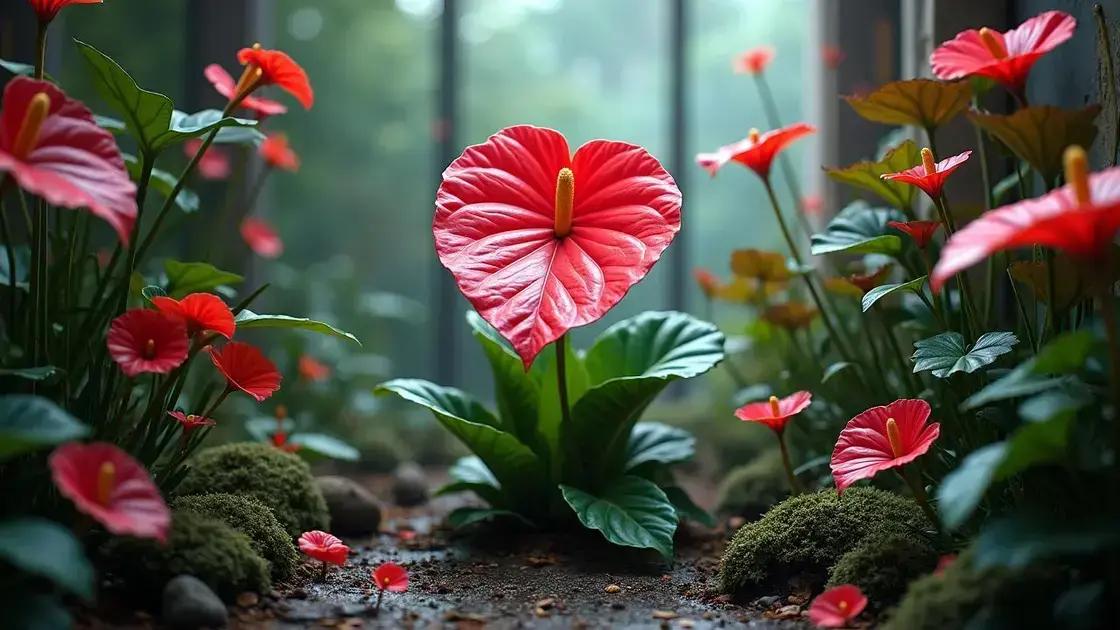How to Care for an Anthurium Plant: 7 Expert Tips You Need to Know
How to care for an anthurium plant might sound simple, but many struggle with these vibrant beauties. These plants can be a delight, offering stunning blooms and foliage. By understanding a few key aspects, you can ensure they thrive in your home. Let’s explore the essential light requirements, watering schedules, and how to troubleshoot common anthurium problems.
Table of Contents
ToggleEssential light requirements for anthurium plants
Essential light requirements for anthurium plants are crucial for ensuring their vibrant blooms and healthy foliage. These tropical beauties thrive when provided with the right amount of light. Understanding how to balance their light needs can greatly affect your anthurium’s growth and overall health.
Understanding light conditions
Anthuriums prefer bright, indirect sunlight. Here are some key points about their light preferences:
- Direct sunlight can scorch leaves.
- Low light may result in weak growth and fewer blooms.
- Filtered light or dappled sunlight is ideal.
Best lighting options
To create the perfect environment for anthurium plants, consider these lighting setups:
- Placing them near east or west-facing windows.
- Using sheer curtains to diffuse strong sunlight.
- Rotating the plant weekly to ensure even light exposure.
Signs of inadequate light
Keep an eye out for the following indicators that your anthurium may not be receiving enough light:
- Leggy growth: Long stems with sparse leaves.
- Yellowing leaves: Indicates stress or low light levels.
- No blooms: Lack of flowers even during the blooming season.
Conclusion
Providing proper lighting is vital when learning how to care for an anthurium plant. By following these guidelines, you can help ensure your plant thrives. For more details on exploring indoor gardening techniques, consider checking out additional resources.
Watering and fertilization tips for anthurium care

Watering and fertilization tips for anthurium care are vital in keeping your anthurium healthy and thriving. Understanding how to properly hydrate and nourish your plant is essential for its growth and floral display.
Understanding watering needs
Anthuriums prefer consistently moist soil but are sensitive to overwatering. Here are some essential tips:
- Water when the top 1-2 inches of soil feel dry.
- Use room temperature water to avoid shocking the roots.
- Ensure proper drainage to prevent root rot.
Best watering practices
Follow these proven watering techniques for optimal plant health:
- Water the plant thoroughly until you see water draining from the bottom.
- Adjust watering frequency based on humidity levels — increase in summer and decrease in winter.
- Consider using distilled or rainwater for the best results.
Fertilization guidelines
Feeding anthuriums appropriately contributes to vibrant blooms. Here are guidelines for fertilization:
- Fertilize every 4-6 weeks during the growing season with a balanced liquid fertilizer.
- Reduce feeding in the fall and winter when growth slows.
- Use a fertilizer formulated for flowering plants for best results.
Signs of over-fertilization
Be aware of these symptoms that indicate over-fertilization:
- Leaf tip burn: Browning of leaf tips suggests too much fertilizer.
- Slow or stunted growth: Nutrient build-up can lead to growth issues.
- Yellowing leaves: Indicates a potential imbalance in nutrients.
Conclusion
Proper watering and fertilization are crucial when learning how to care for an anthurium plant. By following these tips, you can ensure your plant remains vibrant and healthy. For additional advice on exploring indoor gardening techniques, check out other expert resources.
Common problems and solutions for thriving anthuriums
Common problems and solutions for thriving anthuriums are vital knowledge for any plant enthusiast. Understanding these challenges and their remedies can keep your plant healthy and beautiful.
Identifying leaf issues
Leaf problems are among the most visible signs of anthurium distress. Here are some common issues:
- Yellowing leaves: Often a sign of overwatering or nutrient deficiency.
- Brown tips: May result from underwatering or low humidity levels.
- Dark spots: Possible indication of fungal infections.
Solutions for leaf problems
Addressing leaf issues will help your anthurium thrive:
- Check soil moisture before watering to avoid root rot.
- Increase humidity by misting regularly or using a humidity tray.
- Use a fungicide if fungal infections are suspected.
Pest control strategies
Pests can weaken your anthurium and affect its growth. Common pests include:
- Spider mites: Small, reddish pests that create webbing.
- Mealybugs: White, fluffy insects found in leaf axils.
- Scale insects: Hard, shell-like pests that adhere to stems.
Effective pest solutions
To rid your anthurium of pests, consider these methods:
- Inspect your plants regularly and isolate infested plants immediately.
- Use insecticidal soap or neem oil as a natural pesticide.
- Wash affected leaves with a mixture of water and mild soap.
Environmental factors to consider
Lack of proper conditions can stunt your anthurium’s growth. Monitor the following:
- Temperature: Ideal range is between 65°F and 80°F.
- Light: Ensure bright, indirect sunlight without scorching direct rays.
- Watering: Maintain consistent moisture without over-saturation.
Conclusion
By recognizing common problems and implementing these solutions, you can maintain a thriving anthurium. For more insights on exploring indoor gardening techniques, don’t hesitate to seek additional resources.
In conclusion
Caring for your anthurium requires attention to various factors such as light, water, and nutrient needs. By implementing the tips and solutions outlined, you can prevent common issues and ensure your plant thrives beautifully. Remember, a healthy anthurium not only adds vibrant color to your space but also enhances the overall ambiance of your home. For tips on enhancing your indoor garden, explore additional resources that can help you become a more successful plant parent.

